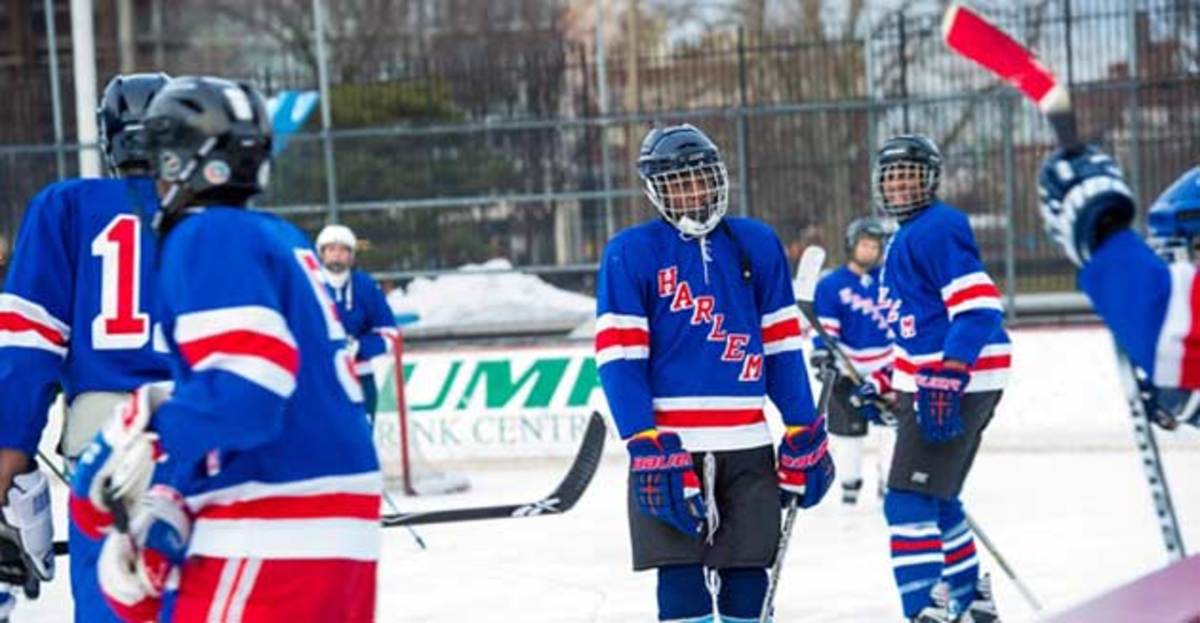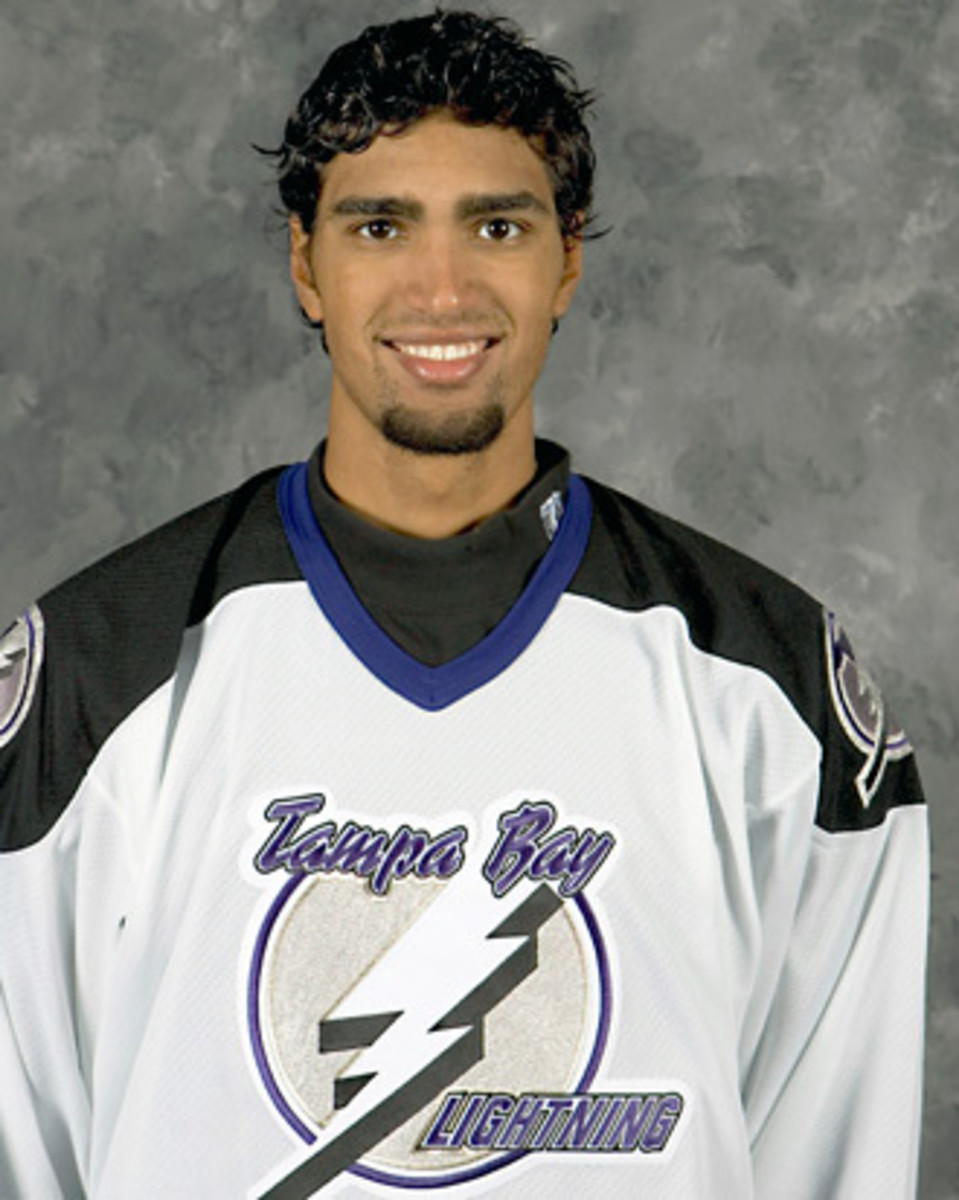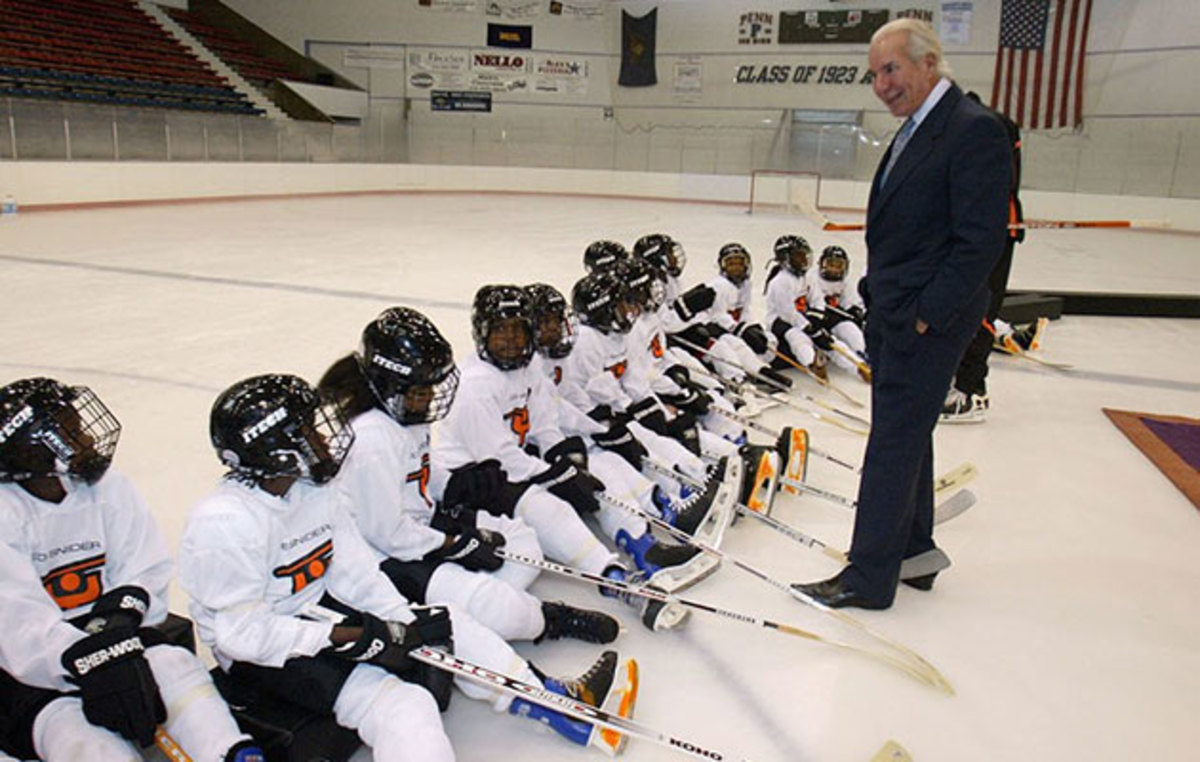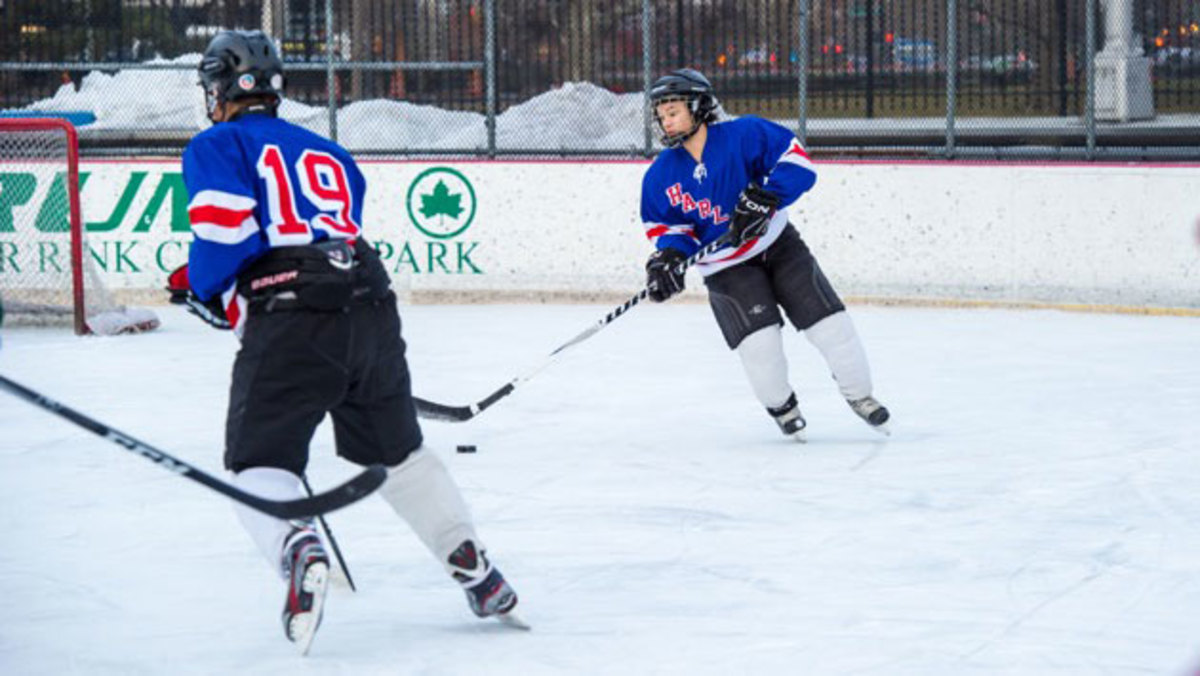Hockey Is For Everyone helping to grow the game

Your teams. Your favorite writers. Wherever you want them. Personalize SI with our new App. Install on iOS (iOS or Android)
NEW YORK — It’s about 10 minutes before 7 p.m. on a winter Friday, and a crisp 30 degrees outside. Kids struggle to carry hockey bags that weigh as much as they do, while parents patiently suggest they hurry up because they might be late. Bright lights shine down on Lasker Rink, which serves as a pool during the summer months. But on this chilly evening in Harlem, there is a “Winter Classic” feel in Central Park.
From afar, it looks like an ordinary practice, but Harlem resident John Sanful shares stories that explain how it’s more than just a group of children playing hockey. The executive director of Ice Hockey in Harlem, Sanful talks about kids who have been a part of the program and later went on to college, the kid who now watches his own child skate at Lasker, and how Harlem has changed.
Since 1987, Ice Hockey in Harlem has been giving kids ages five to 17 a chance to play and learn the sport while also providing access to educational opportunities.
Coach Bruce Freifeld, who has been with Ice Hockey in Harlem for 17 years, is on the ice going over drills. Freifeld, who Sanful says has an “infectious” spirit, played college hockey at the University of Alaska from 1979-81. He believes that it’s just part of the culture of the sport to give back after you hang up your skates competitively.
• Desert Bloom: Vegas expansion, Auston Matthews point to new era
“Just like Martin St. Louis,” he says, comparing himself to the retired NHL forward. “I saw a little thing on him. He is coaching hockey like everybody else.”
On a bench outside the rink, Cherokee Hart, a program assistant and student at Lehman College, helps a child with her skate.
“I like this ice the best,” the young girl says as Hart helps tighten the laces. “This, this is my home ice.”
Hart, who moved from North Carolina to Harlem when she was 14, shares how when she first became involved with the organization she was amazed by the opportunities the program provided for minorities.
“I just played basketball,” she says. “I wish I knew this was an option.”
***

Thanks to Ice Hockey in Harlem and the other similar programs that are a part of the NHL’s Hockey Is For Everyone (HIFE) initiative, youth from minority and low-income communities are getting a chance to hit the ice and develop an appreciation for a sport they might otherwise never experience. As Sanful puts it, “Today, it’s not unusual hopping on the train and seeing a kid of color with a hockey bag.”
HIFE, which was originally called the NHL Diversity Program, will celebrate its 20th anniversary in 2018. The program is planted all over the country, from New York City to Oakland, Calif, with programs in Florida and other parts of the south, as well as in Canada. It's funded with annual grants by the league ($50,000) and USA Hockey ($150,000) that help pay for ice time and equipment. Beside teaching kids how to skate, stickhandle and shoot, HIFE programs require their participants to partake in various classes, such as hockey knowledge, college exploration and life skills.
Q&A: Soul on Ice filmmaker Damon Kwame Mason
According to Ken Martin, senior vice president of fan development and diversity programing for the NHL, Hockey Is For Everyone was never solely intended to tackle the issue of diversity in the sport. Instead, it uses hockey as a catalyst to address other issues, such as socialization, improving academic scores and promoting positive life skills. Nor is the point of the program to create the next Alex Ovechkin or Sidney Crosby, Martin says. But that doesn’t mean it can’t be the early beginning of something more. Just ask Gerald Coleman, who was the first HIFE alumnus to play in the NHL when he joined the Tampa Bay Lightning in 2005. The goaltender saw action in two NHL games and spent nine seasons in the AHL and ECHL before retiring in 2014.
Coleman, who grew up in Evanston, Illinois, credits an HIFE program for teaching him the game and many valuable life lessons. But he wasn’t always supported while playing hockey. He recalls a physical education teacher giving him a bad grade during his freshman year of high school because he was upset that the 6' 5" Coleman didn’t try out for the basketball team.
“‘Why are you playing this white man’s game,’ is what he told me,” Coleman says.
That moment, and often being the target of racial slurs on the ice, reminded him that he was different, but HIFE gave him a different outlook.

“Once I got involved with kids who looked like me, [playing] felt more comfortable. That kind of gave me the experience of everyone can do it,” he says. “It was more of an empowerment thing, knowing there were other kids out there like me that wanted to do this… It made me feel like at least I fit in somewhere. It made me want to move forward and continue to play hockey. ”
As he moved through the professional hockey ranks, Coleman said other players of color would form a bond and camaraderie. He adds that he was fortunate to be a part of organizations that supported him
“They didn’t care what I looked like, as long as a stopped the puck, was respectful and did my job," he says. “That’s all anyone really cared about.”
• Mama Ward the backbone of gritty Joel's NHL career
Coleman, who is now attending Oakland University in Rochester, Mich., and plans to study physical therapy at the University of Alaska-Anchorage, said HIFE was a turning point for him because it made him want to pursue hockey and believe there could be a future if he worked hard.
“They told me that there were a lot of options to get out of where you are came from and in hockey you learn so many core values as a person, so even if you don’t make it to the highest level, you will still take something away from it.”
The SI Extra Newsletter Get the best of Sports Illustrated delivered right to your inbox
Subscribe
The man who serves as the face of the HIFE program is Willie O’Ree, the first black player to see action in an NHL game when he took the ice with the Boston Bruins on January 18, 1958.
“It just happened to happen,” O’Ree humbly says about his historic status. “It didn’t really dawn on me till the next day that I broke the color barrier, I just read it in the paper. I didn’t say I was the Jackie Robinson [of hockey]—it was the media. So it’s a nice feeling to be associated with Mr. Robinson.”
O’Ree was approached by the NHL 18 years ago to be the ambassador for HIFE. The retired forward, who currently resides in La Mesa, a suburb of San Diego, was working security at the posh Hotel Del Coronado when he got the call to join.
When O’Ree first started, there were only five programs that were a part of HIFE. Now there are 30. The 80-year-old used to travel 15 days a month to the various programs and events, but has now cut down to 10. This past season, he was in Boston for the Winter Classic, Nashville for the NHL All-Star Game, and the Red Wings-Avalanche Stadium Series game in Denver. He even has an event named after him, the Willie O’Ree Winter Classic, an annual celebration where the program brings in kids from across the country to participate in activities. The game is played in a different city each year, and in Febuary the festivities were held in Philadelphia, where the Ed Snider Foundation, another HIFE program, hosted the event.
The Ed Snider Foundation has been involved with HIFE for the past 10 years. The foundation’s president and CEO, Scott Tharp, offers an anecdote when asked about how programs like his are exposing hockey to more kids, and as a result diversifying the sport among youth.
His tale begins about six years ago on a Saturday in February, when the late Snider, the owner of the Philadelphia Flyers, came out to a rink for a game. A team from West Philadelphia, which is predominately African American, was about to play a group of kids from the Kensington rink, which is predominantly Hispanic.
• Flyers driven by passion of late owner Ed Snider
When Scott and Snider entered the stands they were in awe.
“The first thing [Snider] said to me was, ‘Scott, you know I have been in hockey for over 45 years and this is the first time I have ever heard anyone cheering in Spanish at a hockey game,’” Tharp recalls.
Scott describes the scene in the stands as the seas parting in order for everyone to hug, kiss and thank Snider.
“We knew then that we were really onto something,” Tharp says. “All of a sudden folks who could have made their judgments on external factors—the color of skin, the color of hair, the color of eyes, were all of a sudden united by an internal commonalty—a love for hockey and a love that their kids had for the sport of hockey.”

Flyers forward Wayne Simmonds serves as a board member for the Snider foundation, along with other players who have been involved such as Danny Briere and Kimmo Timonen. Tharp even recalls Wayne Gretzky making an appearance one year.
O’Ree has had the opportunity to chat with current players in the NHL of different races. He has played in Scott Gomez’s golf tournament, refers to P.K. Subban as “a great human being and a terrific hockey player,” and references numerous conversations he has had with Simmonds.
• Evgeny Romasko, NHL’s first Russian referee, learning on the fly
“The first thing they say to me is ‘Willie, I just can’t imagine what you guys had to go through to make it possible for guys like me to play in the league. I just can’t imagine some of the things you had to overcome,’” O’Ree says. “And that’s a nice feeling to hear this from a player that is playing from the league today and has never seen my play but heard about me. They never saw me play in an arena.”
Recently, O’Ree made headlines, as San Jose Sharks forward Joel Ward stated during the Stanley Cup playoff media day that the NHL should retire O’Ree’s number.
Manon Rheaume, NHL's first female goalie, continues to inspire
“I definitely think Willie should be recognized for sure,” Ward said. “It’s a no-brainer. Without Willie, it would be tough for me to be sitting here today.”
Although HIFE has seen extreme growth since its existence, it doesn’t come without its set of challenges. Ice time and access to rinks are usually major issues. Although the program is able to pay for the costs of the equipment, the number of rinks is sparse.
Ice time is key to the growth of these programs, and the Ed Snider program can attest to that. The foundation partnered with the city to renovate and operate five rinks throughout the city. There is even one located in the Kensington neighborhood that visiting teams playing the Flyers will use for practice.
Despite some challenges programs face, they have seen growth. Currently, the Ice Hockey in Harlem program has a waitlist, but set up a floor hockey program for those kids who are waiting to get on the ice. Kids of different backgrounds, who otherwise might play other sports, are waiting to put on skates.
“These boys and girls get on the ice and they have the opportunity to interact with other boys and girls of different religions and different colors,” O’Ree says. “And when you’re on the ice, you’re just a hockey player.”

Around 8:30 p.m. in Harlem on that Friday evening, the wind has picked up. One group gets off the ice and another gets on. The next day they will head to Connecticut for a game. The New York Department of Corrections is on the ice to practice with the kids, a special guest appearance outside the classroom, where they often come to give lectures about ways to succeed in life. They, too, have a big game coming up against the Suffolk County Department of Corrections, with an expected crowd of 1,000.
• Pierre McGuire's road goes on forever
Sanful talks to parents, mingles with some members of the DOC and then looks out on the ice to see which players have improved since the start of the season.
“I wish I had a program like Ice Hockey in Harlem when growing up. I would have been introduced to the sport a lot sooner,” he says. "Plus, when I was playing, not a lot of kids looked like me and you sort of have to find yourself when you are out there, find your confidence.”
With programs like Hockey Is For Everyone, in places like Harlem, maybe that won’t be the case for much longer.
